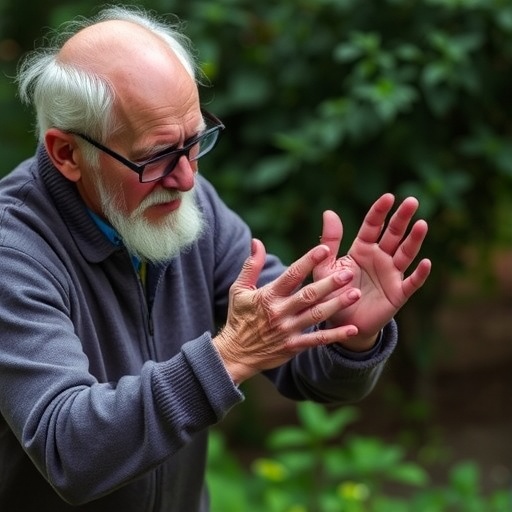In the realm of geriatric research, understanding the impact of frailty on functional capabilities has gained increasing attention. A recent study conducted by Kaneno et al. sheds light on the intricacies of frailty, particularly focusing on how this condition affects the adjustability of grasping force among community-dwelling older adults. This cross-sectional study, published in a prestigious journal, highlights significant implications for both clinical practices and preventive strategies in elder care, urging a deeper examination of what frailty means for the elderly population.
Frailty, a complex syndrome characterized by decreased reserve and diminished resistance to stressors, has become a focal point in geriatric health discussions. As individuals age, their physiological functions decline, leading to issues such as reduced muscle strength, fatigue, and impaired balance. These factors contribute to what is known as frailty, which can severely affect an individual’s ability to perform daily activities. Kaneno and colleagues aimed to quantify this relationship, focusing on how frailty influences the ability to adjust grasping force, a critical aspect of daily life for older adults.
The methodology of the study was rigorous, employing standardized assessments to gauge participants’ frailty levels and their grasping force capabilities. Using a sample that encompassed a diverse demographic, the researchers measured the grip strength of participants while also evaluating their ability to modulate that strength in response to different objects. Such precision in measurement was crucial, as it allowed the authors to draw statistically significant conclusions about the influence of frailty on motor control, particularly in terms of variable force production.
Understanding the mechanics of grasping is vital. Grasping force involves not just the ability to hold objects but also the capacity to adjust that force dynamically. This adjustment is essential when handling fragile items or performing delicate tasks, which often become more challenging for frail older adults. The findings of the study suggest that frailty severely compromises this adjustability, leading to greater difficulty in tasks that require nuanced motor skills. This has broader implications—if frail individuals cannot perform these daily tasks, their quality of life and independence may diminish significantly.
One of the vital contributions of this research lies in its potential to guide interventions that could mitigate the effects of frailty. For example, incorporating resistance training and grip-strengthening exercises into routine care plans for older adults could enhance their functional independence. As the study indicates, a tailored approach to physical rehabilitation that addresses both strength and motor control may substantially benefit frail older populations, fostering better adjustment to daily activities they may struggle with.
Moreover, the implications extend beyond physical capability. The psychological aspect plays a huge role in the lives of community-dwelling older adults. As individuals face increasing difficulties with daily tasks due to frailty, anxiety and depression may arise. These mental health issues can, in turn, exacerbate frailty, creating a vicious cycle. The research highlights the importance of an integrated approach to elderly care, combining physical rehabilitation with mental health support to ensure a holistic path to improving the quality of life.
In addition to clinical implications, this study also signals a call for further research in the field. The authors emphasize the need for longitudinal studies that can explore the trajectory of frailty’s impact on motor control over time. The relationship between frailty and adjustability of grasping force may have underlying biological mechanisms that can be unraveled through more extensive investigations. Understanding these pathways could provide significant insights into preventative measures that could be taken before the onset of frailty.
As we continue to navigate an aging population, insights from studies like these will prove invaluable. They provide actionable data that can influence public health policies, leading to initiatives that promote physical activity among older adults. By investing in programs designed to enhance strength and motor skills, communities can foster environments that not only extend lifespan but also enhance the quality of life for their aging residents.
Furthermore, the study opens doors to discussions on assistive technologies designed to support frail older adults. By understanding the specific challenges these individuals face, innovators can develop devices that assist with grip strength and adjustability. Such advancements could significantly enhance daily living for those struggling with frailty, enabling them to maintain greater independence and engagement with their surroundings.
In conclusion, Kaneno et al.’s research illuminates the profound effects of frailty on grasping force adjustability in older adults. By emphasizing the importance of this relationship, the authors provide a framework for future research and actionable interventions that may not only improve the lives of many but also advance the field of geriatric health care. As this area of research continues to evolve, the learning derived from such studies will undoubtedly shape the way we approach aging and frailty.
Ultimately, the recognition of frailty as a key factor in health outcomes for older adults signifies an essential shift in geriatric care. Addressing these issues through targeted physical rehabilitation, supportive technologies, and a comprehensive understanding of the psychological ramifications not only improves individual lives but also enhances societal well-being. The journey to understanding frailty is far from complete, but contributions like those of Kaneno and his colleagues are crucial stepping stones toward a healthier, more resilient aging population.
Subject of Research: The effect of frailty on the adjustability of grasping force in community-dwelling older adults.
Article Title: The effect of frailty on the adjustability of grasping force in community-dwelling older adults: a cross-sectional study.
Article References:
Kaneno, T., Sato, A., Akizuki, K. et al. The effect of frailty on the adjustability of grasping force in community-dwelling older adults: a cross-sectional study.
BMC Geriatr 25, 898 (2025). https://doi.org/10.1186/s12877-025-06428-0
Image Credits: AI Generated
DOI: https://doi.org/10.1186/s12877-025-06428-0
Keywords: frailty, grasping force, older adults, motor control, geriatric health, quality of life.




